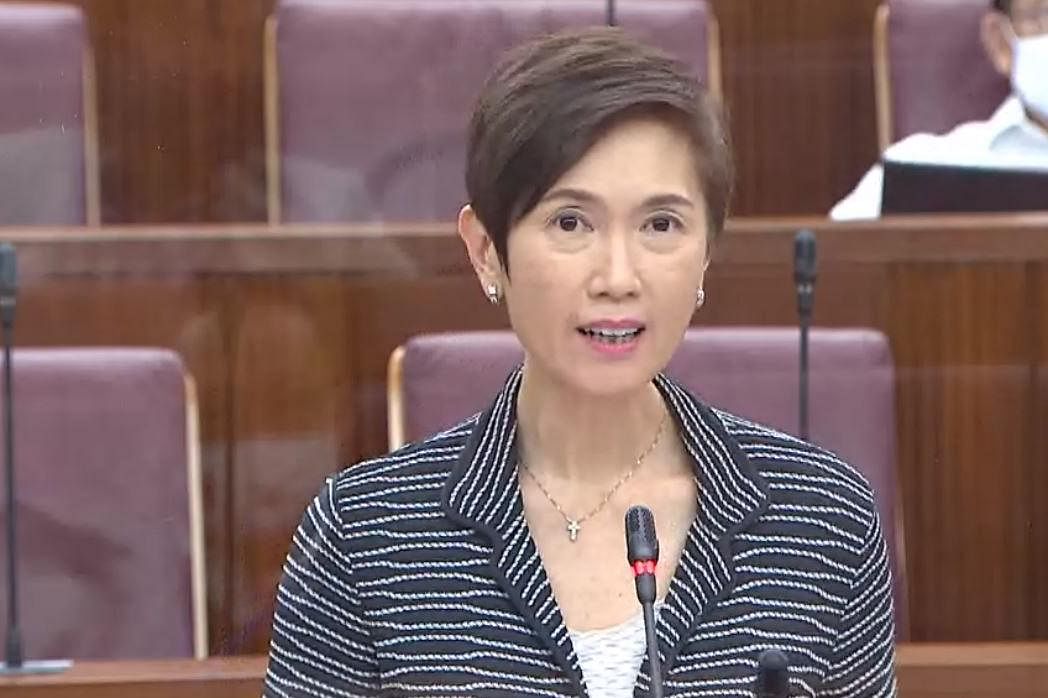SINGAPORE - Companies which voluntarily pay progressive wages and provide job advancement pathways for lower-income workers will be recognised with a Progressive Wage Model (PWM) Mark, as part of efforts to lift wages for lower-income workers, said Manpower Minister Josephine Teo on Tuesday (Sept 1).
Sectors like food services and retail trade have the potential to come on board, which would expand the implementation of the PWM - which she described as a "minimum wage plus" - beyond the three sectors where it is currently mandated: cleaning, security and landscaping.
Speaking in Parliament during the debate on the President's Address, Mrs Teo said that for the PWM Mark to work, there must be a broader movement involving the entire society.
"As consumers, we must be prepared to pay slightly more, and intentionally support such progressive companies by purchasing their products and services. This will spur more companies to be progressive and adopt the PWM Mark, which in turn will benefit our lower-income workers," she said.
The PWM, pioneered by the National Trades Union Congress (NTUC) in 2012, is a ladder that sets out minimum pay and training requirements for workers at different skill levels, and covers around 80,000 workers across the three sectors where it is mandated.
Speaking before Mrs Teo, NTUC deputy secretary-general Koh Poh Koon highlighted in his speech on Tuesday that efforts taken by the tripartite partners prior to the Covid-19 pandemic will lead to the lifts and escalator maintenance sector PWM becoming mandatory in 2022.
The labour movement is also in discussions to see how the model can be implemented for the waste management sector, he added.
Dr Koh, who is also Senior Minister of State for Health, said that the Government must also be prepared to use more regulatory levers to widely implement the model, and that waiting for the market to move on its own will not produce results.
"In moving towards universal PWM, we should explore setting a sectoral wage benchmark for companies as a first step in sectors where there are currently no regulatory levers to mandate a PWM," he said.
Sectoral wage benchmarks may help catalyse more companies in sectors with a more variegated employment landscape, such as in food services and retail, to embark on uplifting the livelihoods of low-wage workers, Dr Koh noted.
Both Mrs Teo and Dr Koh acknowledged that it is not the best time to raise wages, given the current global health and economic crisis.
"Timing is important. We do not want to put businesses out of action through escalating wage costs in an economic downturn, nor do we want to deter hiring of workers in a distressed job market with rising unemployment rate," Dr Koh said.
"Even as we endeavour to help low-wage workers, we must make sure a balance is struck, so that 'low-wage' does not become 'no-wage'," he said.
Mrs Teo said that while it may be risky to mandate the model in more sectors at present, the Government can still promote voluntary adoption of the model, which is the rationale behind the introduction of the PWM Mark in collaboration with tripartite partners.
In her speech, she highlighted that the Government has complemented the PWM with Workfare benefits and skills training for low-wage workers.
Workers in the three sectors where PWM is mandatory have seen cumulative wage growth of around 30 per cent in the last five years, compared to the median cumulative wage growth of 21 per cent.
But there is scope for expansion, Dr Koh highlighted, as the sectors where PWM is mandated represents 15 per cent of all the workers in the lowest 20th percentile of salary ranges.

Singapore should leverage on skills ladders mapped out by SkillsFuture Singapore to move towards universal PWM across all lower-paying job roles, in line with Industry Transformation Maps objectives of upskilling, job redesign, productivity growth and wage progression, he said.
Mrs Teo said that in other sectors not covered by PWM, Workfare and the Special Employment Credit have also raised wages.
The Government's preferred approach to uplift low-wage workers has four prongs, she noted.
First, to regularly adjusting Workfare to support employability while mitigating income inequality.
Second, to raise wages in PWM sectors at an appropriate pace.
Third, to expand PWM over time to more sectors, assessing the capacity of businesses to absorb the change.
Fourth, to raise standards of living for lower-income workers in ways such as acquiring skills, home ownership, and access to quality healthcare and education.
This approach has been supported through measures such as the expanded Workfare coverage and higher payouts introduced earlier this year, and a Workfare special payment of $3,000 to cushion the impact of the virus pandemic, Mrs Teo said.


